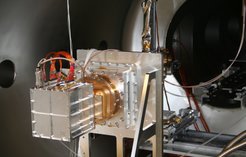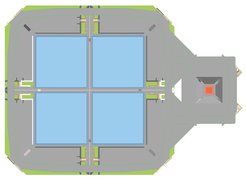X-ray detector development
eROSITA PNCCD detectors
The focal plane of the eROSITA (extended Roentgen Survey with an Imaging Telescope Array) instrument is equipped with an array of seven identical PNCCD cameras. The PNCCD sensor wafers were produced at the semiconductor laboratory of Max-Planck Society. The detector concept is based on that of the XMM-Newton PNCCD, which is in operation without significant degradation of performance since the launch of the ESA satellite in 1999. The eROSITA CCD chip is tailored to the requirements of the project, e.g. the pixel size, the number of pixels, the on-chip optical blocking filter, and a frame store section. Tests of the advanced PNCCD detectors for eROSITA verified the improvements over XMM-Newton: the excellent low-energy response permits spectroscopy even at photon energies of 200 eV (see Fig.1) and the low read noise of 2.5 electrons rms is important for accurate recombination of events with signal charge split over adjacent pixels. All eROSITA PNCCDs were tested at chip-level including spectroscopic performance by means of a unique so-called cold chuck probe station to select the seven best CCDs. The quantum efficiency and the detector response of these CCDs were measured at the synchrotron BESSY II in Berlin in the energy range from 1.9 eV to 11 keV. With a series of proton irradiation experiments at the TANDEM accelerator in Garching, we evaluated and verified the radiation hardness of the eROSITA detectors.


Before start of the assembly of the flight detectors, we measured and optimized the performance by testing of engineering models (see figures left and right). The optimum operating conditions regarding supply voltages, timing sequences and temperature are already determined. A complete qualification of the eROSITA QM detector (figure below) has been performed and the flight detector assembly and tests have meanwhile started.

ATHENA-WFI detector

Another X-ray sensor type based on active pixels sensors (APS) with a DEpleted P-channel Field Effect Transistor (DEPFET) in each pixel has been developed for future challenging projects in space. The first application of such a DEPFET detector will be the Mercury Imaging X-ray Spectrometer (MIXS) on board of the Mercury Planetary Orbiter (MPO) of ESA‘s BepiColombo mission. For this purpose an array of 64 x 64 macropixels with pixel size of 300 µm x 300 µm and time resolution of 165 µs was designed and produced at the MPI semiconductor laboratory. The flight detectors have been assembled, tested, calibrated at the BESSY II synchrotron, and integrated into the flight instrument. An important issue was the radiation hardness of the detector which was successfully tested at the TANDEM accelerator in Garching with protons.
Prototypes of DEPFET sensors with even faster readout are presently developed for the Wide Field Imager (WFI) camera of the Athena satellite. It comprises a large area detector (14 cm x 14 cm) composed of 4 quadrants and a small fast timing detector. The latter one uses a special DEPFET type, a gateable DEPFET with intermediate storage region meaning a separation of signal collection and readout area. The collected signal charge is then either transferred to the DEPFET for signal processing or - by implementation of a second DEPFET in the pixel – is read out by one DEPFET while the other one is integrating. By such a concept, accidental falsification of the photon energy measurement and dead time can be almost completely avoided. First tests with prototypes were successful.
The homogeneity of the pixel response is an issue and has to be studied because of the large format of the planned sensors with 512 x 512 pixels. With a pixel size of about 130 µm x 130 µm, one of the sensor chips is already larger than the XMM-Newton PNCCD detector. The readout of the DEPFET active pixel sensors is planned by operation in rolling shutter mode. The resulting time resolution is approximately 1 ms for the large-area detector and about 20 µs for the fast detector operated in window mode.

Design of the WFI focal plane detector for ATHENA with the large area detector on the left-hand side (in blue color) and the fast timing detector on the right-hand side (in red color).
The ASIC which performs the analog processing of the sensor signals is a key component of the detector apart from the sensor chip. We develop these readout ASICs, i.e. their concept and layout, and combine them with the PNCCDs or DEPFET active pixel sensors to a detector system. None of the ASICs is commercial off-the-shelf; they need to be tailored to the individual project specifications. For eROSITA we use the well-proven CAMEX concept. This is an improved version of the ASIC used for the PNCCD camera on board of XMM-Newton and allows lower noise and faster readout. For the readout of the DEPFET sensors of the BepiColombo mission, a new ASIC, called ASTEROID, has been developed.
For our new project ATHENA-WFI, we chose a novel concept, called VERITAS-2. It is the first ASIC able to readout the DEPFETs both in source follower mode and in drain current mode. Every readout channel of the 64-channel ASIC implements a trapezoidal weighting function. The ASIC has been produced and is under test.
Selected MPE High Energy Publications in this area:
Meidinger et al. 2010, Nucl. Instr.& Meth. A, 624, 321 · Meidinger et al., 2012, Proc. SPIE, 8453, 84530P · Norbert Meidinger et al., 2014, Proc. SPIE, 9144, 91222J · Porro et al., 2014, Proc. SPIE 9144, 91445N




